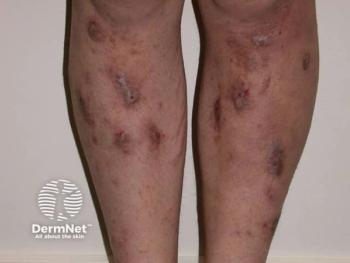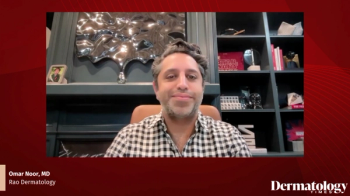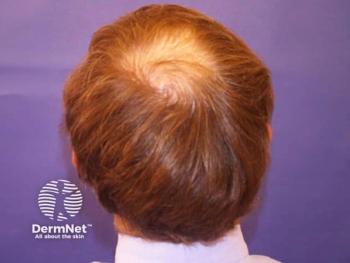
Filler concepts, techniques continue to evolve
Currently available fillers and filler techniques are changing the way dermatologists approach volume loss in the midface and beyond, according to experts at Cosmetic Surgery Forum, held in Las Vegas.
Las Vegas - Currently available fillers and filler techniques are changing the way dermatologists approach volume loss in the midface and beyond, according to experts at Cosmetic Surgery Forum, held here.
Henceforth, says Daniel Cassuto, M.D., “We’re going to use fillers the way we use autologous fat today. It’s more a surgical way of thinking. We must stop thinking about lines and consider how the whole three-dimensional structure of the face keeps shrinking with age.” He is professor of plastic, reconstructive and aesthetic surgery, University Hospital of Modena, Italy.
Chicago-based facial plastic surgeon Steven Dayan, M.D., notes that the convexities and concavities of the face - and the way the light reflects off them - allow people to recognize signs of aging. Accordingly, he says, facial rejuvenation is “not about removing wrinkles. Removing wrinkles is obvious. It’s about slightly altering the face and our perceptions of the face to make it look more attractive. It’s harder to do this in older patients because the changes you have to make a much more dramatic. But in young people, you can make quite a difference with just a little bit of neuromodulator or filler.”
After aesthetic treatments, Dr. Dayan says, “The differences should be so subtle that they are unrecognized by the naked eye. In fact, they are recognized by the subconscious, not the conscious, mind.” To that end, “I try to make patients more attractive by making small, less than 1 mm changes, such as lifting the corner of the eye.”
When comparing pre- and post-treatment photos of such a patient, “You can see that there are subtle changes - the brows are slightly lifted and farther apart. And there are changes with the muscle patterns in the forehead” that contribute to a more youthful first impression.
Filler favorites
Regarding specific procedures and indications, Murad Alam, M.D., says that for volumizing, his favorite filler is Sculptra (poly-L-lactic acid/PLLA, Valeant), particularly in the cheeks. It gives natural-looking results without leaving skin feeling like something has been injected beneath it, he says. Dr. Alam is professor of dermatology, otolaryngology and surgery and chief of the section of cutaneous and aesthetic surgery at Northwestern University, Chicago.
“Patients must be made aware that the effect will not be immediate,” Dr. Alam says. “And photography is imperative to document that. But if you have a patient who can wait a couple months,” and return for two or three follow-up appointments during that stretch, PLLA allows such gradual improvement that their co-workers and family members aren’t surprised.
For tear troughs, Dr. Alam typically uses Restylane (hyaluronic acid/HA, Medicis) because thicker fillers such as PLLA and calcium hydroxylapatite carry significant risks of persistent lumpiness in this area. The fact that one can reverse HA’s effects with hyaluronidase reassures patients, he says.
“Patients are often a little squeamish, especially in the beginning, about getting fillers injected around their eyes,” he says.
Additionally, Dr. Alam says Restylane has less of a tendency to absorb water in this location than Juvéderm (HA, Allergan) does, and this helps avoid unwanted gradual swelling a few months post-treatment.
For perioral rhytids, Dr. Alam says, filler choice depends on the depth of the defects. For example, he says that for elderly patients with significant volume loss, “I usually prefer Radiesse (calcium hydroxylapatite, Merz), which I mix 3:2 with saline and lidocaine so that it becomes somewhat less viscous and easier to inject around the mouth, without causing lumpiness or bruising.”
Patient age matters
For patients in their 20s and 30s who are just beginning to experience hollowing in the chin area, he adds, “Restylane works very nicely, as do many other HAs. That’s where one can use the pillow technique - inject vertically, just gently press the plunger, almost imperceptibly, and that causes the skin to swell up in areas that previously were depressed.”
Also, Dr. Alam says he has recently focused more on filling the chin.
“I have always filled the marionette lines and the folds immediately above the lip. But now we’re filling these inferior lateral areas that sit below and a little to the lateral edge of the mental crease. In particular, I use an L-shaped technique to fill both the marionette line and that area, which seems to improve the lower-face contour,” he says.
Dr. Cassuto adds that for a 65-year-old female patient with extended marionette lines, he injected Juvéderm Volift (HA, Allergan), a less concentrated member of the Juvéderm family that’s approved in Europe.
“Another product you can use as if it were collagen is Juvéderm Volbella (HA, Allergan). It’s not concentrated - it’s 15 mg/mL. But it does have good longevity,” Dr. Cassuto says.
Overall, he said that this product and the entire Vycross product family - Juvéderm Voluma, Volift and Volbella - integrates effectively with surrounding tissues and contours, without lumps. Other fillers available in Europe that integrate well include the cohesive polydensified matrix family - Belotero Basic (available in the United States as Belotero Balance; HA, Merz), Belotero Intense and Belotero Volume, Dr. Cassuto adds.
“This is partly due to the properties of the new materials, and partly because of the new way of injecting and thinking about injections,” he says.
Nevertheless, Dr. Alam generally avoids fillers for acne scars. “This is a lifetime problem,” he explains, “and many of these patients want a permanent solution. Fillers entail the need for repeat treatment, unless you’re using permanent fillers,” which could create other problems.
“I prefer to use lasers - most commonly nonablative fractionated resurfacing lasers - here, even for patients with very severe scarring. If you treat often enough, nonablative lasers work pretty well without creating prolonged downtime,” Dr. Alam says.
Sometimes, however, Dr. Alam says he uses calcium hydroxylapatite for large, depressed, rolling acne scars.
“I inject into the depressed rolling scar and make the valley into a hill,” he says. “Then I place a thumb on both sides of the injection point, and gently depress to extrude the excess material. It’s easier to overfill and then push out than to inject exactly the right amount to begin with.”
Similarly, he says, Belotero (HA, Merz) can be helpful for very fine residual ice pick scars.
Cannula considerations
Over the past year and a half, Dr. Alam says, he has almost completely converted to cannulas for filler injections. Dr. Cassuto says injecting with cannulas is “much more natural for a surgeon because this is the way we inject fat.” In contrast, he says, needles are too imprecise for this purpose.
Furthermore, Dr. Cassuto says that with microcannulas, “You don't have to inject a big bolus in a non-anatomical way.” Rather, he says that by using a group of injections performed with the subcutaneous microthreading technique, local accumulations can be avoided.
“You can get away with superficial placement of thicker products,” Dr. Cassuto says.
To physicians who have grown frustrated with the bendable nature of cannulas, Dr. Alam says, “It’s probably your choice of cannula. I find that in my hands, a 1.25-inch, 27-gauge medium rigid cannula works best. If it’s too long, it flops around, and you don’t know where the tip is." Compared to needles, he says, this cannula dramatically decreases bruising, especially in the perioral area, although he still uses needles for cheek augmentation with PLLA, and for fine etched lines.
In recent years, Dr. Cassuto says that except for patients who have undergone massive weight loss, “I have stopped performing facelifts because I don’t believe they are indicated. For rejuvenation, tissues should be treated, not cut.”
Morbidly obese patients experience tissue expansion that leaves them with very fibrotic subcutaneous layers, he says.
“Whether they have lost weight or not, and also for practical reasons and the fact that many patients are not capable of undergoing facial surgery, we try to ‘procrastinate’ by using fillers for a long time,” Dr. Cassuto says. “As we have seen in these people, repeated injections over the years make the subcutaneous layers much younger - the fibrosis is reversed,” and the patient’s skin feels like that of a person up to 20 years younger.
“I believe there may be some permanency to filler products, or at least permanent outcomes,” Dr. Dayan adds. “How many papers have we seen where five or six years later, the product is still there?”
For minute defects of the nose following rhinoplasty, Dr. Dayan says, he often very carefully injects fillers. Frequently, “I’ll inject a patient once, and she never needs it again.”
Disclosures: Drs. Cassuto and Alam report no relevant financial interests. Dr. Dayan is a consultant, speaker or investigator with Allergan, Valeant and Merz.
Newsletter
Like what you’re reading? Subscribe to Dermatology Times for weekly updates on therapies, innovations, and real-world practice tips.


















